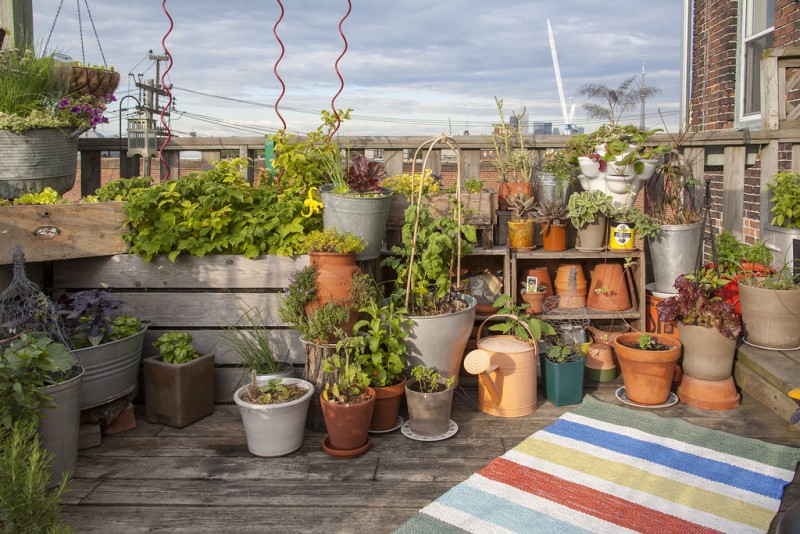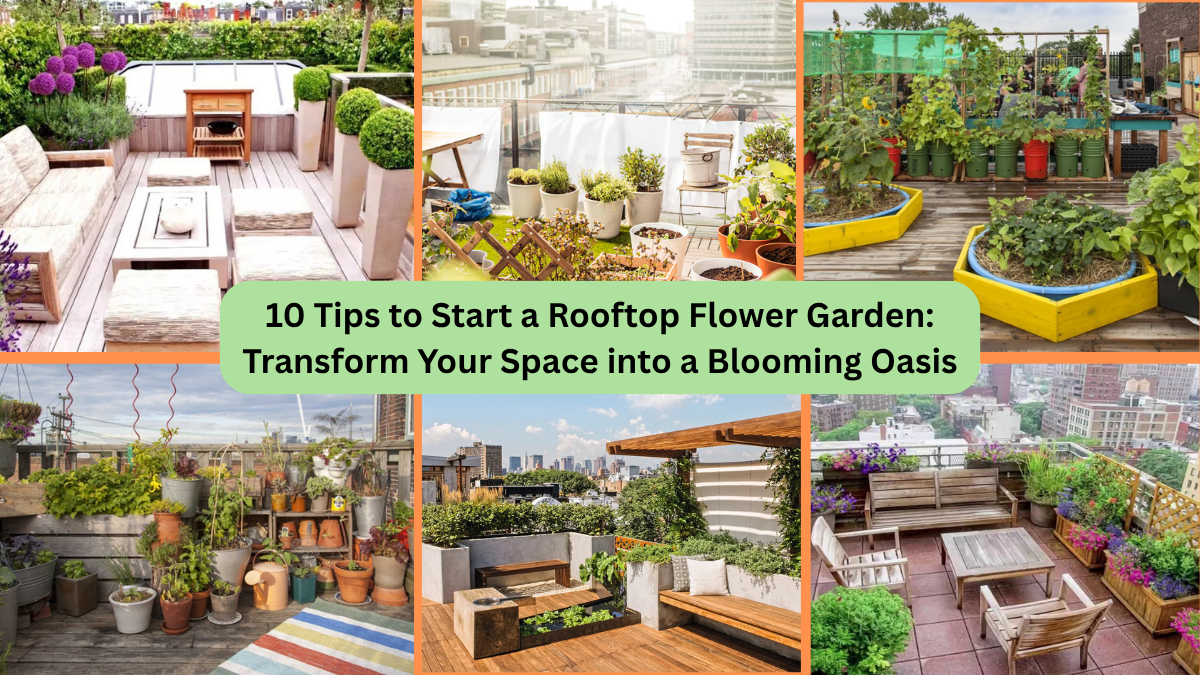Urban living doesn’t mean you have to give up your love of gardening. If you have access to a rooftop, why not turn it into a vibrant flower garden? Rooftop flower gardens are perfect for city dwellers wanting to enjoy nature, fresh air, and colorful blooms right above the hustle and bustle.
Starting a rooftop flower garden might seem challenging, but with the right tips, you can create a lush, thriving floral sanctuary that adds beauty, reduces stress, and even helps the environment.
In this guide, we’ll share 10 practical tips to help you start a successful rooftop flower garden that flourishes season after season.

Why Start a Rooftop Flower Garden?
Before diving into the tips, here are some great reasons to start your own rooftop flower garden:
- Utilize unused space: Rooftops are often neglected but can become vibrant green areas.
- Escape urban stress: Gardening improves mood, reduces anxiety, and connects you with nature.
- Improve air quality: Plants filter pollutants and cool the air around your building.
- Support pollinators: Flowers attract bees, butterflies, and birds, helping local ecosystems.
- Create privacy and shade: Plants can block noise and shield you from neighbors.
- Enhance aesthetics: A colorful flower garden boosts curb appeal and personal enjoyment.

Tip 1: Check Building Regulations and Roof Safety
Before starting your rooftop flower garden, ensure you understand your building’s rules and roof structure.
- Permissions: Check with your building manager or local authorities about any restrictions on rooftop use.
- Weight limits: Soil, pots, water, and plants add weight. Confirm that your roof can safely support the garden.
- Waterproofing: Make sure the roof has proper waterproofing to prevent leaks.
- Safety measures: Install railings or barriers if needed to prevent falls.
- Access: Consider ease of access for daily care and watering.
Getting these details right early will save headaches later.

Tip 2: Plan Your Garden Layout Thoughtfully
Space is limited on rooftops, so plan carefully.
- Assess sunlight: Most rooftops get full sun, but note any shaded areas from structures or vents.
- Use vertical space: Incorporate trellises, hanging pots, or wall-mounted planters to maximize planting area.
- Group plants: Place flowers with similar water and sunlight needs together for easier care.
- Create pathways: Leave enough space to move around without damaging plants.
- Consider wind: Rooftops can be windy, so position taller plants where they get wind protection or add windbreaks.
Sketch a rough garden plan before buying supplies.

Tip 3: Choose the Right Containers and Soil
Proper containers and soil are essential for healthy rooftop flowers.
- Containers: Use lightweight pots made from materials like plastic, fiberglass, or resin. Avoid heavy ceramic or concrete pots.
- Drainage: Ensure containers have drainage holes to prevent root rot.
- Size: Choose pots that accommodate your plant’s root system but aren’t so large that they become heavy and cumbersome.
- Soil: Use high-quality potting mix formulated for container gardening. It should be well-draining but retain moisture.
- Additives: Consider adding water-retaining crystals or organic matter to help with moisture control.
Good containers and soil provide the foundation for success.

Tip 4: Select Flower Varieties That Thrive on Rooftops
Rooftop gardens have unique conditions, so pick flowers that are hardy and suited for containers.
- Sun lovers: Marigolds, zinnias, petunias, geraniums, and lavender flourish in full sun.
- Wind-resistant: Choose sturdy flowers like nasturtiums, salvias, and cosmos that can handle breezy conditions.
- Drought-tolerant: Succulent flowers like kalanchoe or sedum are great for lower watering needs.
- Compact varieties: Dwarf or bushy plants fit well in limited space.
- Seasonal interest: Mix annuals and perennials for continuous bloom and varying textures.
Selecting the right flowers reduces maintenance and increases enjoyment.

Tip 5: Master Watering Techniques for Rooftop Gardens
Watering is a rooftop gardener’s biggest challenge due to exposure to sun and wind.
- Consistent watering: Container plants dry out faster, so water regularly, especially in hot weather.
- Self-watering pots: Consider using pots with reservoirs to reduce watering frequency.
- Mulch: Apply a layer of organic mulch on top of soil to retain moisture and regulate temperature.
- Water early or late: Water in the morning or evening to reduce evaporation.
- Use drip irrigation: Automated drip systems save time and ensure even watering.
Good watering practices keep your flowers healthy and vibrant.
Tip 6: Provide Nutrients Through Regular Feeding
Container soil loses nutrients quickly, so regular feeding is important.
- Use balanced fertilizer: Choose a water-soluble fertilizer formulated for flowering plants.
- Frequency: Feed every 2-4 weeks during the growing season.
- Organic options: Compost tea, fish emulsion, or seaweed extract are excellent natural fertilizers.
- Slow-release pellets: These provide steady nutrients over time.
- Follow instructions: Avoid over-fertilizing, which can harm plants.
Proper feeding ensures continuous blooming and strong growth.
Tip 7: Protect Your Garden from Wind and Harsh Weather
Rooftops are exposed to intense winds and sun, which can stress plants.
- Windbreaks: Use screens, lattice panels, or tall shrubs to reduce wind impact.
- Shade cloth: Provide temporary shade during extreme heat to prevent sunburn.
- Staking: Support tall or leggy plants with stakes or cages.
- Bring plants indoors: Consider bringing delicate plants inside during storms or cold snaps.
- Use heavy pots: To prevent tipping during wind gusts.
Taking precautions helps your garden thrive despite rooftop challenges.
Tip 8: Incorporate Pollinator-Friendly Practices
Boost your rooftop garden’s ecological value by attracting pollinators.
- Choose pollinator-friendly flowers: Such as coneflowers, bee balm, sunflowers, and cosmos.
- Avoid pesticides: Use natural pest control methods to protect bees and butterflies.
- Add a water source: A shallow dish with water and pebbles supports visiting pollinators.
- Diverse planting: Grow a variety of flower shapes and colors to appeal to different species.
A pollinator-friendly garden benefits both your flowers and local wildlife.
Tip 9: Plan for Seasonal Changes and Maintenance
A rooftop flower garden requires ongoing attention to stay beautiful.
- Rotate plants: Replace spent annuals with new seasonal flowers for continuous color.
- Prune regularly: Deadhead flowers and trim back overgrown stems to encourage growth.
- Clean containers: Wash pots at the end of the season to prevent disease.
- Inspect for pests: Check plants weekly and treat any infestations promptly.
- Prepare for winter: Move sensitive plants indoors or cover pots if you live in cold climates.
Good maintenance keeps your rooftop garden healthy year-round.
Tip 10: Make Your Rooftop Garden a Relaxing Retreat
Beyond flowers, create a welcoming atmosphere where you can unwind.
- Add seating: Include comfortable chairs or benches.
- Use lighting: String lights or solar lanterns extend enjoyment into the evening.
- Incorporate scents: Grow fragrant flowers like jasmine or gardenias.
- Decorate: Use garden art, colorful pots, and cushions to personalize your space.
- Create privacy: Use tall plants, trellises, or screens to create a cozy vibe.
A rooftop flower garden is not just about plants—it’s about creating your own urban sanctuary.
Final Thoughts
Starting a rooftop flower garden is an exciting way to bring nature into your urban lifestyle. By carefully planning, choosing the right plants, and maintaining your garden with these 10 tips, you can transform any rooftop into a stunning, colorful oasis.
With patience and care, your rooftop flower garden will reward you with beauty, relaxation, and the satisfaction of growing your own little piece of paradise high above the city.
So, grab your gardening gloves, containers, and seeds, and start your rooftop flower adventure today!





